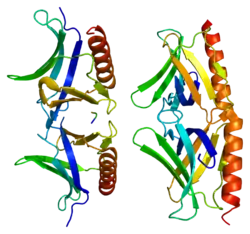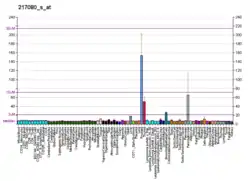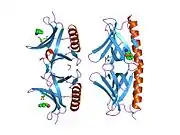HOMER2
Homer protein homolog 2 is a protein that in humans is encoded by the HOMER2 gene.[5][6][7]
This gene encodes a member of the homer family of dendritic proteins. Members of this family regulate group 1 metabotrophic glutamate receptor function. The encoded protein may be involved in cell growth. Four transcript variants encoding distinct isoforms have been identified for this gene.[7]
References
- GRCh38: Ensembl release 89: ENSG00000103942 - Ensembl, May 2017
- GRCm38: Ensembl release 89: ENSMUSG00000025813 - Ensembl, May 2017
- "Human PubMed Reference:". National Center for Biotechnology Information, U.S. National Library of Medicine.
- "Mouse PubMed Reference:". National Center for Biotechnology Information, U.S. National Library of Medicine.
- Tu JC, Xiao B, Yuan JP, Lanahan AA, Leoffert K, Li M, Linden DJ, Worley PF (Dec 1998). "Homer binds a novel proline-rich motif and links group 1 metabotropic glutamate receptors with IP3 receptors". Neuron. 21 (4): 717–26. doi:10.1016/S0896-6273(00)80589-9. PMID 9808459.
- Xiao B, Tu JC, Petralia RS, Yuan JP, Doan A, Breder CD, Ruggiero A, Lanahan AA, Wenthold RJ, Worley PF (Dec 1998). "Homer regulates the association of group 1 metabotropic glutamate receptors with multivalent complexes of homer-related, synaptic proteins". Neuron. 21 (4): 707–16. doi:10.1016/S0896-6273(00)80588-7. PMID 9808458.
- "Entrez Gene: HOMER2 homer homolog 2 (Drosophila)".
- Feng, Wei; Tu Jiancheng; Yang Tianzhong; Vernon Patty Shih; Allen Paul D; Worley Paul F; Pessah Isaac N (Nov 2002). "Homer regulates gain of ryanodine receptor type 1 channel complex". J. Biol. Chem. United States. 277 (47): 44722–30. doi:10.1074/jbc.M207675200. ISSN 0021-9258. PMID 12223488.
Further reading
- Soloviev MM, Ciruela F, Chan WY, McIlhinney RA (2000). "Molecular characterisation of two structurally distinct groups of human homers, generated by extensive alternative splicing". J. Mol. Biol. 295 (5): 1185–200. doi:10.1006/jmbi.1999.3436. PMID 10653696.
- Feng W, Tu J, Yang T, et al. (2003). "Homer regulates gain of ryanodine receptor type 1 channel complex". J. Biol. Chem. 277 (47): 44722–30. doi:10.1074/jbc.M207675200. PMID 12223488.
- Kim JT, Park SH, Kim SK, et al. (2003). "Potential role of Homer-2a on cutaneous vascular anomaly". J. Korean Med. Sci. 17 (5): 636–40. doi:10.3346/jkms.2002.17.5.636. PMC 3054924. PMID 12378015.
- Strausberg RL, Feingold EA, Grouse LH, et al. (2003). "Generation and initial analysis of more than 15,000 full-length human and mouse cDNA sequences". Proc. Natl. Acad. Sci. U.S.A. 99 (26): 16899–903. Bibcode:2002PNAS...9916899M. doi:10.1073/pnas.242603899. PMC 139241. PMID 12477932.
- Shiraishi Y, Mizutani A, Mikoshiba K, Furuichi T (2003). "Coincidence in dendritic clustering and synaptic targeting of homer proteins and NMDA receptor complex proteins NR2B and PSD95 during development of cultured hippocampal neurons". Mol. Cell. Neurosci. 22 (2): 188–201. doi:10.1016/S1044-7431(03)00037-X. PMID 12676529. S2CID 38323844.
- Rong R, Ahn JY, Huang H, et al. (2003). "PI3 kinase enhancer-Homer complex couples mGluRI to PI3 kinase, preventing neuronal apoptosis". Nat. Neurosci. 6 (11): 1153–61. doi:10.1038/nn1134. PMID 14528310. S2CID 807407.
- Gerhard DS, Wagner L, Feingold EA, et al. (2004). "The status, quality, and expansion of the NIH full-length cDNA project: the Mammalian Gene Collection (MGC)". Genome Res. 14 (10B): 2121–7. doi:10.1101/gr.2596504. PMC 528928. PMID 15489334.
- Ishibashi T, Ogawa S, Hashiguchi Y, et al. (2005). "A novel protein specifically interacting with Homer2 regulates ubiquitin-proteasome systems". J. Biochem. 137 (5): 617–23. doi:10.1093/jb/mvi074. PMID 15944415.
- Rual JF, Venkatesan K, Hao T, et al. (2005). "Towards a proteome-scale map of the human protein-protein interaction network". Nature. 437 (7062): 1173–8. Bibcode:2005Natur.437.1173R. doi:10.1038/nature04209. PMID 16189514. S2CID 4427026.
- Dahl JP, Kampman KM, Oslin DW, et al. (2006). "Association of a polymorphism in the Homer1 gene with cocaine dependence in an African American population". Psychiatr. Genet. 15 (4): 277–83. doi:10.1097/00041444-200512000-00010. PMID 16314758. S2CID 24128233.
This article is issued from Wikipedia. The text is licensed under Creative Commons - Attribution - Sharealike. Additional terms may apply for the media files.






